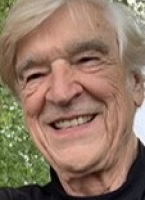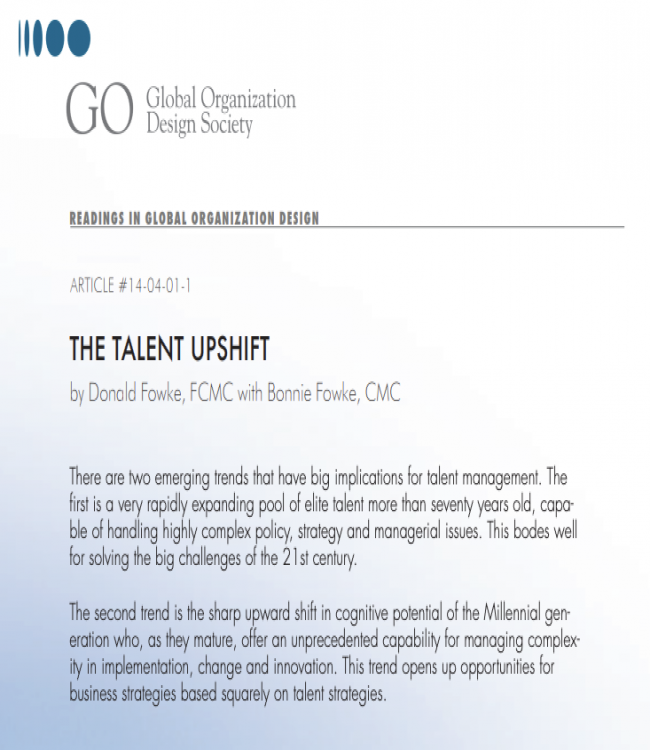A plenary presentation by Don Fowke & Bonnie Fowke at a GO Society World Conference in NYC including a video, a Prezi animation, and an article
- There are more capable people available who are 70 years old and older. The second is that we've got smarter millennials and that companies and governments that grasp these trends will have the ability to shape the future as never before.
- The flyn effect describes how IQs have risen by 3% per decade over the 20th century. Now, I also see a different thing happening in the big cities. This is the creative class. These are opportunities that just aren't even being grasped. We need to embrace these demographic changes.
- Moore's Law will create capacity for us to use technology and the brains of these two emerging groups of people to get at the problems that the society has. My suggestion is this that we need to get the old timers on side before they get you.
Speaker A We had an important presentation by Don Folk this evening and wanted to make space for that and to have the room cool so we could pay more attention. So just to say this, that I've been privileged to watch Don's intellectual curiosity, his reading, and the breadth of how he applies a requisite in a variety of ways. And so I think you'll see by his presentation the scope of his thinking and his work, and how he's trying to find ways to present this in a way that's attractive and communicates well with others so they understand. So I hope you find his remarks provocative and stimulates discussion. So I consider Don one of the original elders of our group, and we celebrate him. Thank you very much. Our chairman.
Speaker B So I was reading Alan Greenspan's most recent book, and he's very pessimistic about U. S. Growth because he's basically saying, we've got all these challenges that that is outlined here, but we aren't getting any smarter. And I want to talk to you about some work that my partner Bonnie and I have been working on over the winter, that the basic thesis here is that Alan Greenspan has got it wrong and that we've got the capacity in the society to handle the challenges that dad Simon has outlined. And I want to base this argument here on two emerging trends that have big implications for talent management. Now, the first is that there are more capable people available who are 70 years old and older. The second is that we've got smarter millennials and that companies and governments that grasp these trends will have the ability to shape the future as never before. These trends are supported by underlying patterns in the demographics in most of the Western world and also by improvements in smarts described by the Flynn Effect. Let's look at these in turn. In 2014, Western industrialized countries are younger than at any time in history and will remain so through the middle of the century. Now, how can I say that when we all know that we're in an aging population? The reason I can say that is that while the average age of the population is rising, but the remaining life expectancy is rising faster, it is expected that of the millennial generation born in the last 30 years, half of them will live to see their hundredth birthday. So we've got an aging population in one sense, but in terms of life expectancy, we've got a population that's getting younger. So being old at simply 65 is simply wrong. Now, I want to show you how this all works, and I'm going to use the Jax Talent Pool Maturation data sheet as my basis for my argument here. And I'm going to talk about Ted Rogers and the Jack's curves. Now, Ted Rogers is a very famous Canadian entrepreneur who passed away a few years ago. And this chart is, of course, Elliot's famous talent pool maturation data sheet and Ted Rogers'career curve is shown in the yellow envelope in the mode curve there that ends at mode seven. And these blue dots show turning points in his career where he passed, in this case, from stratum four to stratum five, and from five to six and six to seven. And you can see this very clearly in the man's history. Now, the thing here is that first thing here to note is that Ted Rogers died in his early seventy s, and he was still very active in his business. And if Ted's life expectancy, as is happening to the younger generation, were longer than that, you can see that his trajectory was still up. And while, when Elliot did these curves, he stopped the curves at 70. I want you to imagine what these curves might look like if they went out to 100, because in the high stratum, high mode aspects of the curve, these curves are still rising rapidly at the end. Now, just so you can place yourself in terms of the total population, the green curve there is the average employee in an organization that's about the median or the average of the capacity of the average employee. The pink band are typically trained professionals, so that you can see they start out in stratum two and they end up in stratum three. Those of you haven't spent time with these curves, you should, because I think Elliot said one time that this was probably the most important copyrighted piece that he produced in his lifetime. The insights in this particular chart. So I'm going to talk about two things here. I'm going to talk about the curves extending farther beyond 70, and I'm going to talk about something called the Flynn effect, where we'll see that there's an upshift in the bottom parts of the curves. Now, Jack described the changes in capability and in capacity to handle complexity as one move from one stratum to the next as analogous to ice changing to water, and then at the next boundary, water changing to steam or like a change of state. We're not talking about some minor shift in things here. We're talking about a major shift in capability. And while comprising a very small segment of the population, people functioning at stratum five and above as leaders, policymakers, innovators, and other influential roles, have a unique capacity to understand social and economic issues, frame strategies to address them, and organize and manage capacity in the society to address them. In the 20th century, we had an expanding capacity to manage industrial complexity, and Elliot produced this table which showed what happened as the life expectancy of the population went from 50 years old to 70 years old, which is really what happened during the 20th century. And you can see the changes in the right hand side here are very, very substantial in stratum five and above, very, very substantial in terms of the numbers in the population per million. So that's what happened in the 20th century. That was the landscape that Elliot was dealing with when he was writing, studying and writing. Now, in the 21st century, we have expanding capacity. We need expanding capacity to manage global complexity. We're into a new set of problems here, a new set of challenges. And Thad, I think, put his finger right on them. So what happens when we go to a life expectancy of 100 instead of a life expectancy of 70, which is what is happening in this century? Take a look at this set of changes on the right here. And when Alan Greenspan says we're not getting any smarter and we can see that the approximate numbers in the 21 to 70 year old population per million go from three to 103, we've got a major, major change in top leadership, top thinking capacity in the society. And the numbers are also very large as we go down the table there at the bottom. We have much, much stronger capacity in the population emerging here to deal with the problems we're trying to deal with. Now, the other thing I want to talk about is the flyn effect. And here I'm not talking about the higher strata in the population, I'm talking about the people at general manager and below, really up to Stratum four. And here are rough estimates of what happens when you apply the flyn effect to the population as it's gone from, say, when Elliot was looking at it in 1960s to 1980s, to 2025, where we have people at the CEO level tripling 152% growth. And we have general management capacity growing by 600%. And we have middle managers capability growing at stratum three growing by 471%. The frontline manager is basically stable and the frontline worker or stratum one capability in the population is dropping. Why is this? These numbers are based on James Flynn's studies of IQ data in the 20th century. And the flyn effect has been a phrase used to describe this, where he measured, tested IQs have risen by 3% per decade over the whole 20th century. And that's what the Flynn effect means. And my thesis here is that that applies as it applies to IQ, it probably applies to the Jax curves, the distribution of population in the Jax curves. And so we get some very, very strong capability here emerging in the population, not just to think our way through the big strategic issues, but to actually make it happen on the ground managerially. Now, how does this work? How does this Flynn effect actually work? Well, this is the Dickens flyn model that's been posited as how this is actually happening in the population. He talks about an individual multiplier where the genes, which is the basic thing Elliot was basing his thinking on, we get more homework done in the population which magnifies academic the performance advantage that puts people in the top stream when they go to a good university environment so we get an escalating capability in the population. And that there's also a social multiplier where the industrial revolution leads to the scientific worldview, which leads to additional education and new expectations, and parents stimulating, leading to professional jobs and cognitively demanding leisure, which enhances performance. And you get a huge escalation of cognitive skills in a single generation. These are Flyn's words. And this exploring the gains between 19 62,010. Flyn notes the gains paid off in the real world of occupational performance. Doctors and managers and bankers and lecturers and technicians. This is that shift up from stratum one to two and then from two to three and three to four. And it's a two standard deviation shift in the population curve, in the IQ curve. Now, I also see a different thing happening in the big cities. This is my city, Toronto, and you can see the creative class. And this is Richard Florida's ideas from the University of Toronto. And where the creative class works in Toronto is in the blue area. And you can see that it's quite concentrated in the geography. The service class is the, you know, working class people working in Toronto, those little spots up there. So it's already happening, this tremendous concentration in these cities. This would be true in New York, it would be true in the Raleigh Triangle, it would be true in Los Angeles. And wherever this is happening, we could get another multiplier in the workforce that is probably even shifting this harder. So what are the strategic implications of the talent upside? So what well, what we need to do is embrace these demographic changes. These are real. This is really happening. Now. We need to look to smart people, to innovate with new tools and to get more education. We need to understand the distribution of the capability in the population. And if you take a look at what's happening to university educated young people, even in the big cities like Toronto, there are very many people in those levels that aren't being properly utilized by the corporate world. These are opportunities that just aren't even being grasped. Now, so that we've benefited greatly from that in this conference with our friend Kate, who's so ably helped us here. And she's one of these mid 20s, university educated freelancers that does anything and everything. And she's just out there available to be put to work and there are many, many more like her. Now this chart just alludes to why it's important to embrace this capacity. These are the many dimensions of Moore's Law. This is another way of looking at the technological side of the opportunities. These are logarithmic plots of changes in chip speed and number of transistors on a chip and things like that. These trends are real and they're continuing. And this is going to create capacity for us to use technology and the brains of these two emerging groups of people to get at the problems that the society has. Now, my suggestion is this that we need to get the old timers on side before they get you. One of our colleagues is working with a group of former utility executives in their seventy S, eighty s and ninety S in Manitoba who publicly presented options that make Manitoba Hydro squirm. They're just saying, Look, Manitoba Hydro, you're not thinking right about this. And these old guys are making it really tough for the corporate world there. So the lesson get this capacity working for you rather than against you. Thank you very much. It.







